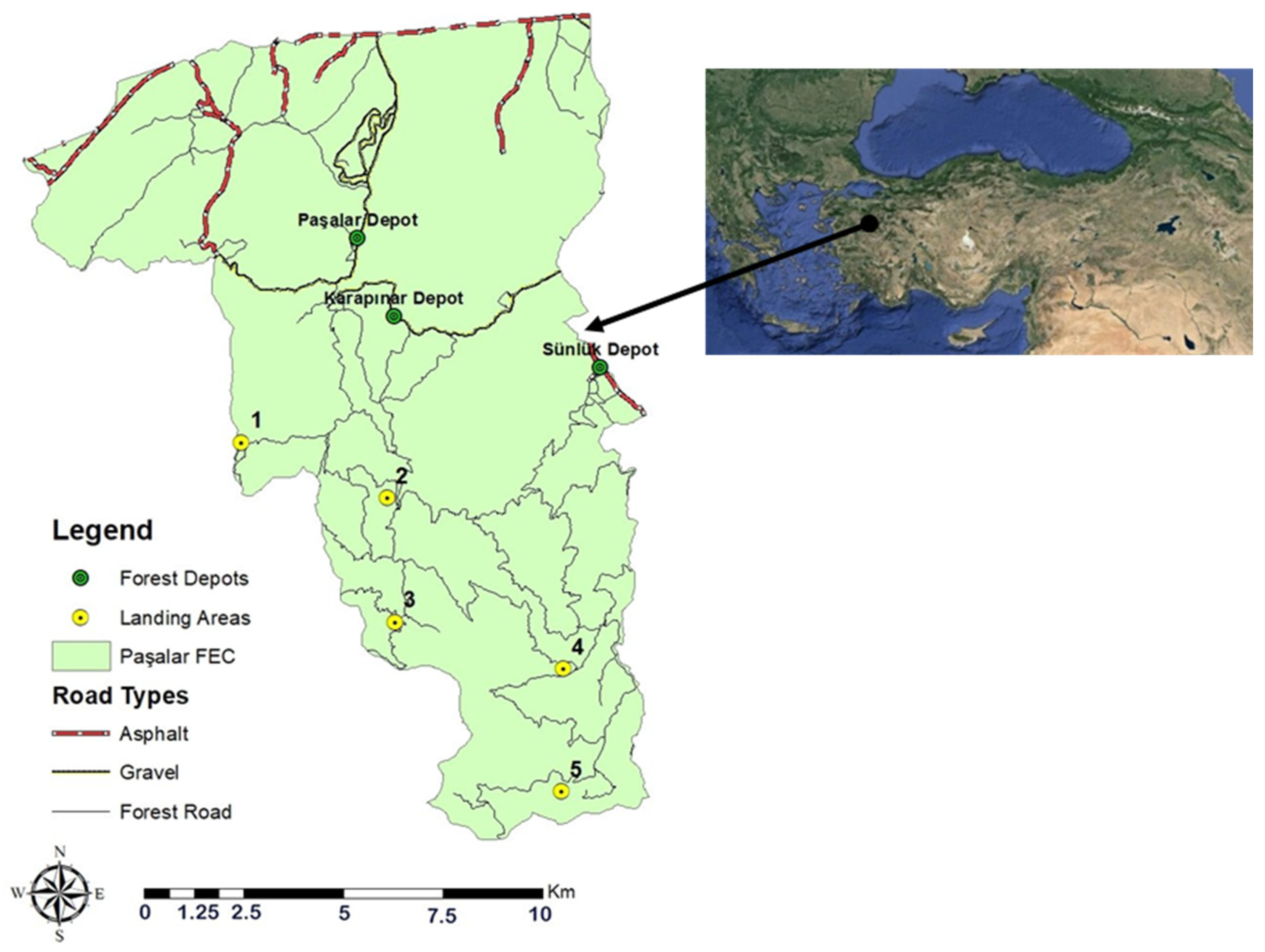Determination of the Safest Route for Logging Trucks Based on Road Types and Conditions †
Abstract
:1. Introduction
2. Methods
2.1. Study Area
2.2. Road Network
2.3. Network Analysis
3. Results and Discussion
4. Conclusions
Funding
Conflicts of Interest
References
- Acar, H.H.; Eroğlu, H. The Planning of Wood Transport on the Forest Roads. Kafkas University. Artvin Fac. For. J. 2001, 1, 61–66. [Google Scholar]
- Aruga, K.; Sessions, J.; Akay, A.E. Heuristic Techniques Applied to Forest Road Profile. Jpn. For. Soc. J. For. Res. 2005, 10, 83–92. [Google Scholar] [CrossRef]
- Akay, A.E.; Doucas, K.; Erdaş, O.; Oğuz, H.; Sivrikaya, F. Using GIS Techniques to Determine Fire Protection Zones Considering Forest Road Network. In Proceedings of the Forest Engineering: Concern, Knowledge and Accountability in Today’s Environment, Hotel Croatia, Dubrovnik (Cavtat), Croatia, 8–12 October 2012. [Google Scholar]
- GDF. Strategic Plan (2013–2017); General Directorate of Forestry, Strategy Development Department: Ankara, Turkey, 2012; 98p.
- Buğday, E.; Menemencioğlu, K. Assessment of Existing Forest Road Standards Conformity for Stumpage Sale in Turkey, II. In Proceedings of the National Mediterranean Forest and Environment Symposium, Isparta, Turkey, 22–24 October 2014. [Google Scholar]
- Akay, A.E.; Erdaş, O. Network Model Approach in Transportation Planning of Forest Products.İstanbul University. Fac. For. J. A-Ser. 2007, 57, 1–20. [Google Scholar]
- Akay, A.E.; Wing, G.M.; Sivrikaya, F.; Sakar, D. A GIS-Based Decision Support System for Determining the Shortest and Safest Route To Forest Fires: A Case Study in Mediterranean Region of Turkey. EMAS 2012, 184, 1391–1407. [Google Scholar] [CrossRef] [PubMed]
- Chung, W.; Sessions, J. Optimization of Cable Logging Layout Using a Heuristic Algorithm for Network Programming. In Proceedings of the Council of Forest Engineering, Auburn, AL, USA, 16–20 June 2002; 104p. [Google Scholar]
- Dijkstra, A.; Drolenga, H.; van Maarseveen, M. Method for Assessing Safety of Routes in a Road Network. Transp. Res. Record. 2007, 2019, 82–90. [Google Scholar] [CrossRef]
- Bonazountas, M.; Kallidromitou, D.; Kassomenos, P.; Passas, N. A decision support system for managing forest fire casualties. J. Environ. Manag. 2007, 84, 412–418. [Google Scholar] [CrossRef] [PubMed]
- Akay, A.E.; Kakol, A.A.H. Forest Transportation Planning by using GIS-based Decision Support System. In Proceedings of the 5th Forest Engineering Conference with 47th International Symposium on Forestry Mechanisation, Gerardmer, France, 23–26 September 2014. [Google Scholar]
- Podolskaia, E.S.; Kovganko, K.K.; Ershov, D.V.; Shulyak, P.P.; Suchkov, A.I. Using of transport network model to estimate travelling time and distance for ground access a forest fire. For. Sci. Issues 2019, 2, 1–24. [Google Scholar] [CrossRef]


| Road Type | Road Conditions | ||
|---|---|---|---|
| Good | Medium | Poor | |
| Asphalt road | 60 | 50 | 40 |
| Gravel road | 40 | 30 | 20 |
| Forest road | 25 | 20 | 15 |
| Road Type | Road Conditions | ||
|---|---|---|---|
| Good | Medium | Poor | |
| Asphalt road | 1 | 2 | 3 |
| Gravel road | 4 | 5 | 6 |
| Type-B forest road | 7 | 8 | 9 |
| Landings | Depots | Timber Volume (m3) | Unit Cost (€/m3) | Transportation Cost (€) |
|---|---|---|---|---|
| 1 | Paşalar | 246 | 0.65 | 160.21 |
| Karapınar | 0.67 | 164.01 | ||
| Sünlük | 1.56 | 383.27 | ||
| 2 | Paşalar | 887 | 0.68 | 601.25 |
| Karapınar | 0.55 | 487.80 | ||
| Sünlük | 0.98 | 867.56 | ||
| 3 | Paşalar | 383 | 0.93 | 357.58 |
| Karapınar | 0.81 | 308.60 | ||
| Sünlük | 1.23 | 472.57 | ||
| 4 | Paşalar | 2407 | 1.38 | 3326.10 |
| Karapınar | 1.25 | 3018.25 | ||
| Sünlük | 1.11 | 2674.71 | ||
| 5 | Paşalar | 415 | 1.87 | 776.12 |
| Karapınar | 1.74 | 723.04 | ||
| Sünlük | 1.46 | 606.90 |
| Landings | Depots | Timber Volume (m3) | Safety Scores | Unit Cost (€/m3) | Transportation Cost (€) |
|---|---|---|---|---|---|
| 1 | Paşalar | 246 | 75 | ||
| Karapınar | 53 | 0.69 | 169.58 | ||
| Sünlük | 100 | ||||
| 2 | Paşalar | 887 | 76 | ||
| Karapınar | 38 | 0.55 | 490.81 | ||
| Sünlük | 67 | ||||
| 3 | Paşalar | 383 | 115 | ||
| Karapınar | 77 | 0.85 | 326.95 | ||
| Sünlük | 106 | ||||
| 4 | Paşalar | 2407 | 107 | ||
| Karapınar | 69 | 1.25 | 3006.64 | ||
| Sünlük | 76 | ||||
| 5 | Paşalar | 415 | 133 | ||
| Karapınar | 95 | 2.20 | 912.31 | ||
| Sünlük | 101 |
Publisher’s Note: MDPI stays neutral with regard to jurisdictional claims in published maps and institutional affiliations. |
© 2020 by the author. Licensee MDPI, Basel, Switzerland. This article is an open access article distributed under the terms and conditions of the Creative Commons Attribution (CC BY) license (https://creativecommons.org/licenses/by/4.0/).
Share and Cite
Akay, A.E. Determination of the Safest Route for Logging Trucks Based on Road Types and Conditions. Environ. Sci. Proc. 2021, 3, 5. https://doi.org/10.3390/IECF2020-08068
Akay AE. Determination of the Safest Route for Logging Trucks Based on Road Types and Conditions. Environmental Sciences Proceedings. 2021; 3(1):5. https://doi.org/10.3390/IECF2020-08068
Chicago/Turabian StyleAkay, Abdullah E. 2021. "Determination of the Safest Route for Logging Trucks Based on Road Types and Conditions" Environmental Sciences Proceedings 3, no. 1: 5. https://doi.org/10.3390/IECF2020-08068
APA StyleAkay, A. E. (2021). Determination of the Safest Route for Logging Trucks Based on Road Types and Conditions. Environmental Sciences Proceedings, 3(1), 5. https://doi.org/10.3390/IECF2020-08068






